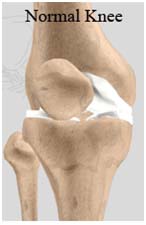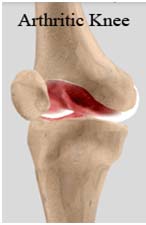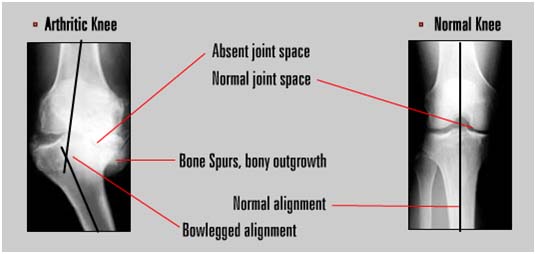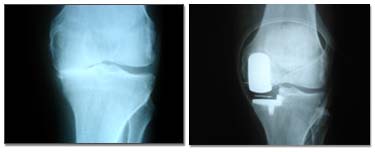If only a single compartment of the knee is worn out, then it may be possible to replace only the worn out component. This is usually done via a minimally invasive approach and the recovery time is much quicker. A 7 to 10cm skin incision is used and the kneecap is not reflected. The worn out surface is prepared. The femoral or tibial component is usually glued or press-fitted in place. The patient can be mobilised four to six hourly post-operatively and can go home after one to three days depending on the amount of pain experienced.
Fig : In an arthritic knee


- The cartilage lining is thinner than normal or completely absent. The degree of cartilage damage and inflammation varies with the type and stage of arthritis.
- The capsule of the arthritic knee is swollen
- The joint space is narrowed and irregular in outline; this can be seen in an X-ray image.
- Bone spurs or excessive bone can also build up around the edges of the joint.
Fig : The combinations of these factors make the arthritic knee stiff and limit activities due to pain or fatigue. 
 Fig :
Fig : Preop xray Postop xray after
Arthritis
Arthritis is a general term covering numerous conditions where the joint surface (cartilage) wears out. The joint surface is covered by a smooth articular surface that allows pain free movement in the joint.
When the articular cartilage wears out, the bone ends rub on one another and cause pain. There are numerous conditions that can cause arthritis and often the exact cause is never known. In general, but not always it affects people as they get older (Osteoarthritis) .
Other causes include
- Trauma (fracture)
- Increased stress e.g., overuse, overweight, etc.
- Infection
- Connective tissue disorders
- Inactive lifestyle- e.g., Obesity, as additional weight puts extra force through your joints which can
- lead to arthritis over a period of time.
- Inflammation e.g., Rheumatoid arthritis
In an arthritic knee
- The cartilage lining is thinner than normal or completely absent. The degree of cartilage damage and inflammation varies with the type and stage of arthritis.
- The capsule of the arthritic knee is swollen
- The joint space is narrowed and irregular in outline; this can be seen in an X-ray image.
- Bone spurs or excessive bone can also build up around the edges of the joint.
The combinations of these factors make the arthritic knee stiff and limit activities due to pain or fatigue.
Diagnosis
- The diagnosis of osteoarthritis is made on history, physical examination & X-rays
- There is no blood test to diagnose Osteoarthritis (wear & tear arthritis)
Advantages & Disadvantages
The decision to proceed with Knee Replacement surgery is a co-operative one between you, your surgeon, family and your local doctor.
The benefits following surgery are relief of symptoms of arthritis.
These include
- Severe pain that limits your everyday activities including walking, shopping, visiting friends, getting in and out of chair, gardening, etc
- Pain waking you at night
- Deformity- either bowleg or knock knee
- Stiffness
Prior to surgery you will usually have tried some simple treatments such as simple analgesics, weight loss, anti-inflammatory medications, modification of your activities, walking sticks, physiotherapy.
Advantages
- Smaller operation
- Smaller incision
- Not as much bone removed
- Shorter hospital stay
- Shorter recovery period
- Blood transfusion rarely required
- Better movement in the knee
- Feels more like a normal knee
- Less need for physiotherapy
- Able to be more active than after a total knee replacement
The big advantage is that if for some reason it is not successful or fails many years down the track it can be revised to a total knee replacement without difficulty.
Disadvantages
Not quite as reliable as a total knee replacement in taking away all pain Long term results not quite as good as total knee
Who is suitable and who is not?
- Ideally should be over 50 years of age.
- When pain and restricted mobility interferes with your lifestyle.
- One compartment involved clinically and confirmed on X-ray.
Who is not suitable?
- Patients with arthritis affecting more than one compartment
- Patients with severe angular deformity
- Patients with inflammatory arthritis eg. rheumatoid arthritis
- Patients with an unstable knee
- Patients who have had a previous osteotomy
- Patients who are involved in heavy work or contact sports
Pre-operation
- Your surgeon will send you for routine blood tests and any other
- investigations required prior to your surgery
- You will asked to undertake a general medical check-up with a physician
- You should have any other medical, surgical or dental problems attended to prior to your surgery.
- Make arrangements around the house prior to surgery
- Cease aspirin or anti-inflammatory medications 10 days prior to surgery
- as they can cause bleeding.
- Cease any naturopathic or herbal medications 10 days before surgery
- Stop smoking as long as possible prior to surgery.
Day of your surgery
- You will be admitted to hospital usually on the day of your surgery.
- Further tests may be required on admission.
- You will meet the nurses and answer some questions for the hospital records.
- You will meet your anaesthetist, who will ask you a few questions.
- You will be given hospital clothes to change into and have a shower prior to surgery.
- The operation site will be shaved and cleaned.
- Approximately 30 mins prior to surgery, you will be transferred to the operating theatre.
Surgical procedure
Each knee is individual and knee replacements take this into account by having different sizes for you knee. If there is more than the usual amount of bone loss sometimes extra pieces of metal or bone are added.
Surgery is performed under sterile conditions in the operating theatre under spinal or general anaesthesia. You will be on you back and a tourniquet applied to your upper thigh to reduce blood loss. Surgery takes about two hours .
The Patient is positioned on the operating table and the leg prepped and draped.
A tourniquet is applied to the upper thigh and the leg is prepared for the surgery with a sterilising solution.
An incision around 7cm is made to expose the knee joint.
The bone ends of the femur and tibia are prepared using a saw or a burr.
Trial components are then inserted to make sure they fit properly.
The real components (Femoral & Tibial) are then put into place with or without cement.
The knee is then carefully closed and drains usually inserted, and the knee dressed and bandaged.
Post-operation coursee
When you wake, you will be in the recovery room with intravenous drips in your arm, a tube (catheter) in your bladder and a number of other monitors to check your vital observations. You will usually have a button to press for pain called Patient Controlled Analgesia (PCA).
Once stable, you will be taken to the ward. The post-op protocol is surgeon dependant, but in general your drain will come out at 24 hours and you will sit out of bed and start moving you knee and walking on it within a day or two of surgery. The dressing will be reduced usually on the 2nd post of day to make movement easier. Your rehabilitation and mobilization will be supervised by a physiotherapist.
To avoid lung congestion, it is important to breathe deeply and cough up any phlegm you may have.
Your orthopaedic surgeon will use one or more measures to minimize blood clots in you legs, such as inflatable leg coverings, stockings and injections into your abdomen to thin the blood clots or DVT's, which will be discussed in detail in the complications section.
A lot of the long term results of knee replacements depend on how much work you put into it following your operation.
Usually you will be in hospital for 3-5 days and then either go home or to a rehabilitation facility depending on your needs. You will need physiotherapy on your knee following surgery.
You will be discharged on a walking aid either on frame or crutches and usually progress to a walking stick at six weeks.
Your sutures are sometimes dissolvable but if not are removed at approx 10 days.
Bending you knee is variable, but by 6 weeks should be to 90 degrees. The aim is to get 110-115 degrees of movement.
Once the wound is healed, you can take a shower. You can drive at about 6 weeks, once you have regained control of your leg. You should be walking reasonably comfortably by 6 weeks.
More physical activities, such as sports previously discussed may take 3 months to be able to do comfortably.
When you go home you need to take special precautions around the house to make sure it is safe. You may need rails in your bathroom or to modify your sleeping arrangements especially if they are up a lot of stairs.
You will usually have a 6 weeks check up with your surgeon who will assess your progress. You should continue to see your surgeon for the rest of your life to check your knee and take X-rays. This is important as sometimes your knee can feel excellent but there can be a problem only recognized on X-ray.
You are always at risk of infections especially with any dental work or other surgical procedures where germs (Bacteria) can get into the blood stream and find their way to your knee.
If you ever have any unexplained pain, swelling, redness or if you feel unwell you should see your doctor as soon as possible.
Risks and complications
As with any major surgery, there are potential risks involved. The decision to proceed with the surgery is made because the advantages of surgery outweigh the potential disadvantages.
It is important that you are informed of these risks before the surgery takes place.
Complications can be medical (general) or local complications specific to the Knee.
Medical complications include those of the anaesthetic and your general well being. Almost any medical condition can occur so this list is not complete.
Complications include:
- Allergic reactions to medications
- Blood loss requiring transfusion with its low risk of disease transmission
- Heart attacks, strokes, kidney failure, pneumonia, bladder infections.
- Complications from nerve blocks such as infection or nerve damage.
- Serious medical problems can lead to ongoing health concerns, prolonged hospitalization or rarely death.
Local complications
*
Infection
Infection can occur with any operation. In the hip this can be superficial or deep. Infection rates are approximately 1%, if it occurs it can be treated with antibiotics but may require further surgery. Very rarely your hip may need to be removed to eradicate infection.
*
Blood clots (Deep Venous Thrombosis)
These can form in the calf muscles and can travel to the lung (Pulmonary embolism). These can occasionally be serious and even life threatening. If you get calf pain or shortness of breath at any stage, you should notify your surgeon.
*
Fractures or breaks in the bone
can occur during surgery or afterwards if you fall. To fix these, you may require surgery.
*
Stiffness in the knee.
Ideally your knee should bend beyond 100 degrees but on occasion the knee may not bend as well as expected. Sometimes manipulations are required, this means going to theatre and under anaesthetic the knee is bent for you.
*
Wear
The plastic liner eventually wears out over time, usually 10 to 15 years and may need to be changed.
*
Wound irritation or breakdown.
The operation will always cut some skin nerves, so you will inevitably have some numbness around the wound. This does not affect the function of your joint. You can also get some aching around the scar. Vitamin E cream and massaging can help reduce this.
Occasionally, you can get reactions to the sutures or a wound breakdown which may require antibiotics or rarely further surgery.
*
Cosmetic Appearance
The knee may look different than it was because it is put into the correct alignment to allow proper function.
Leg length inequality
This is also due to the fact that a corrected knee is more straight and is unavoidable.
*
Dislocation
An extremely rare condition where the ends of the knee joint loose contact with each other or the plastic insert can lose contact with the tibia (shinbone) or the femur (thigh bone).
*
Patella problems
Patella (knee cap) can dislocate that is, it moves out of place and it can break or loosen.
*
Ligament injuries
There are a number of ligaments surrounding the knee. These ligaments can be torn during surgery or break or stretch out any time afterwards. Surgery may be required to correct this problem.
*
Damage to nerves and Blood vessels
Rarely these can be damaged at the time of surgery. If recognized they are repaired but a second operation may be required. Nerve damage can cause a loss of feeling or movement below the knee and can be permanent.
Discuss your concerns thoroughly with your orthopaedic surgeon prior to surgery.




